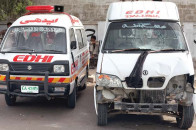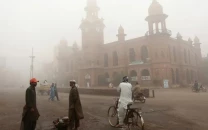Labour rights: Terrorism, power outages hit working class hard
Report on declining employment opportunities paints a gloomy picture of economy.

Labour rights: Terrorism, power outages hit working class hard
“Leaving their homes in Swat, Buner, Lower and Upper Dir, the internally-displaced people were put in camps and suffered greatly before they went back home, only to find their properties and careers completely ruined,” says the Karachi-based non-government organisation, the Pakistan Institute of Labour Education and Research (Piler) in its report launched on Thursday.
Terrorism and power outages are two major factors contributing to the overall decline in the country’s economy that has hit the working class, peasants, women workers hard, says
the report.
Power outages in 2009 alone caused losses of 535,000 jobs, while terrorist acts claimed over 3,000 lives during the year. Losses to the economy stand at $11.5 billion, says the report.
Deteriorating law and order and exclusionary legislation by the military regime have also been identified as key factors contributing to the ailing economy.
Released on Thursday, the report focuses primarily on causes of decline in employment opportunities and the plight of women, especially peasants.
It includes survey reports on workers’ social, economic and industrial issues, wages, harassment and lack of implementation of labour laws.
84.6 per cent of the population earns under $2 per day; 80 out of 130 districts are food insecure; of which 45 are extremely food insecure. Pakistan currently stands at 141 out of 182 countries on the Human Development Index.
The rising external debt, now at 30 per cent of the GDP, has forced the country to seek assistance from international donors. According to the report, tough conditions imposed by these lenders spells further disaster for the working class as the government has withdrawn subsidies on essential items, reduced the social sector’s budget allocation from 60 to 45 per cent and depreciated the currency by a 6-7 per cent.
The report chides existing social security programmes as highly exclusionary. For instance, the Pakistan Employees Social Security Institution (PESSI) and Employees’ Old Age Benefit Institution (EOBI) merely cover 5 per cent of the total workforce, excluding agriculture sector workers.
Employment/unemployment rate
The employment rate currently stands at 5.5 per cent. The total labour force is 53.72 million of which 50.79 million are employed. The share of three major sectors in employment stands at 45 per cent, of which agriculture has 13 per cent, industry has 13 per cent and the services sector 34.3
per cent.
The informal sector comprises 30 per cent of the economy and employs 73 per cent of the labour force.
All major sectors have received a severe blow due to shrinking GDP growth (2 per cent) and soaring inflation (23 per cent). The agriculture sector is in a persistent decline and now stands at 21.8 per cent. The manufacturing sector experienced negative growth at 7.67per cent in 2009-10 due to power shortage, shrinking demand in the export sector and deteriorating law and order in the country.
State’s progress on labour issues
The report censures the eight-year long military regime for leaving behind a number of anti-workers legislation including the IRO 2002, the Finance Act 2006, the Banking Companies Ordinance, the Punjab Industrial Policy 2003, non-implementation of the Seventh Wage Board Award and Removal from Service (Special Power) Ordinance 2000.
The report further states that The Tripartite Conference 2010, called after a lapse of eight years in Feb 2010, also failed as it was neither representational nor consultative.
Women in Employment
Women’s participation in labour force remained low at 21.8 per cent in 2008. Of the total female workforce, 73.8 per cent in 2008 toiled in agriculture mostly as unpaid family workers. Only 12.2 per cent found work in the industrial sector and 13.9 per cent were engaged in the services sector. Only 22.9 per cent of women had access to wage/salaried work.
Agriculture sector and tenants’ resistance
None of the country’s labour laws apply to agricultural workers. A recent survey of Sukkur district indicates a majority of farmers comprise subsistence farmers as 65 per cent have land holdings of up to 12.5 acres. In contrast, only 5 per cent of the farms are under the range of 25 acre to 100 acres. Large landholdings of 100 acres and above, totalling to 5.84 million acres of land are concentrated in less than one percent of total number of the farms, owned by few landlords.
Workers in textile sector
According to a survey conducted on 500 garment workers in 2009 in Karachi, 99 per cent did not possess a written employment letter. Average income of an earner in the average 9 member family is approximately Rs5,000 per month. Data points to a significant 10 per cent child labour.
Published in The Express Tribune, January 1st, 2011.



















COMMENTS
Comments are moderated and generally will be posted if they are on-topic and not abusive.
For more information, please see our Comments FAQ